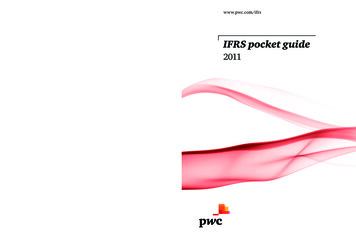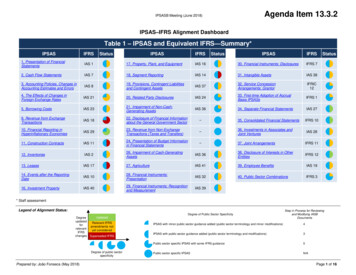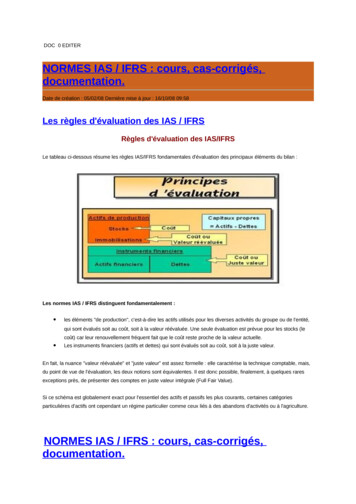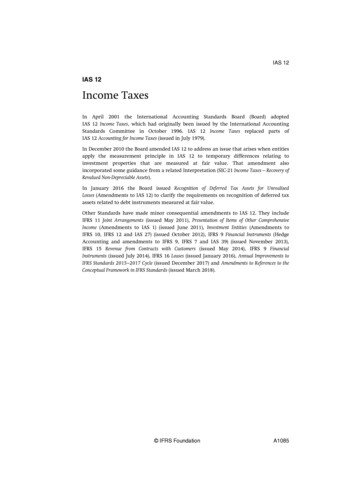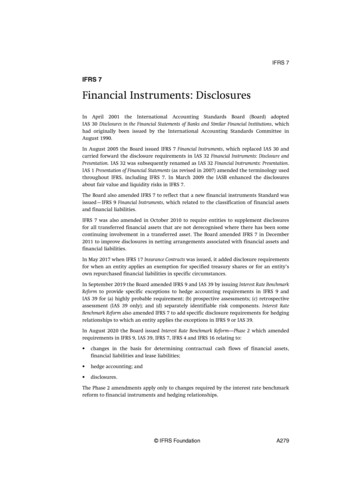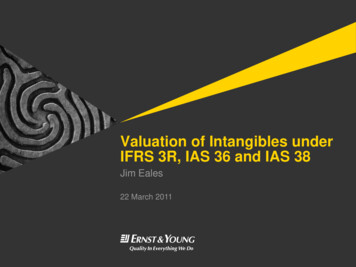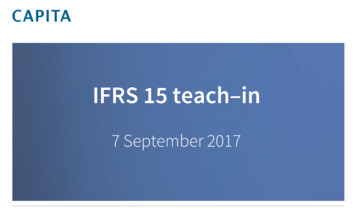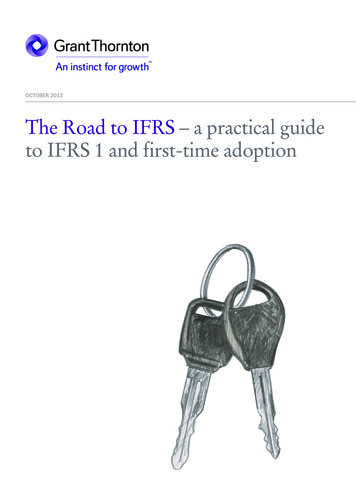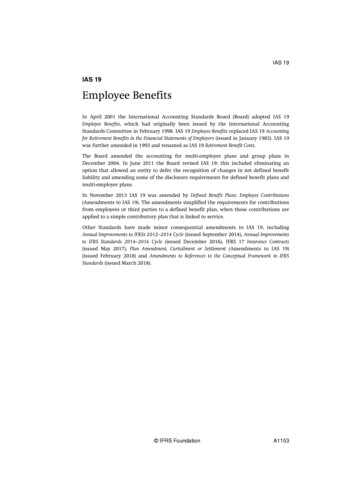
Transcription
IAS 19IAS 19Employee BenefitsIn April 2001 the International Accounting Standards Board (Board) adopted IAS 19Employee Benefits, which had originally been issued by the International AccountingStandards Committee in February 1998. IAS 19 Employee Benefits replaced IAS 19 Accountingfor Retirement Benefits in the Financial Statements of Employers (issued in January 1983). IAS 19was further amended in 1993 and renamed as IAS 19 Retirement Benefit Costs.The Board amended the accounting for multi-employer plans and group plans inDecember 2004. In June 2011 the Board revised IAS 19; this included eliminating anoption that allowed an entity to defer the recognition of changes in net defined benefitliability and amending some of the disclosure requirements for defined benefit plans andmulti-employer plans.In November 2013 IAS 19 was amended by Defined Benefit Plans: Employee Contributions(Amendments to IAS 19). The amendments simplified the requirements for contributionsfrom employees or third parties to a defined benefit plan, when those contributions areapplied to a simple contributory plan that is linked to service.Other Standards have made minor consequential amendments to IAS 19, includingAnnual Improvements to IFRSs 2012–2014 Cycle (issued September 2014), Annual Improvementsto IFRS Standards 2014–2016 Cycle (issued December 2016), IFRS 17 Insurance Contracts(issued May 2017), Plan Amendment, Curtailment or Settlement (Amendments to IAS 19)(issued February 2018) and Amendments to References to the Conceptual Framework in IFRSStandards (issued March 2018). IFRS FoundationA1153
IAS 19CONTENTSfrom paragraphINTERNATIONAL ACCOUNTING STANDARD 19EMPLOYEE BENEFITSOBJECTIVE1SCOPE2DEFINITIONS8SHORT-TERM EMPLOYEE BENEFITS9Recognition and measurement11Disclosure25POST-EMPLOYMENT BENEFITS: DISTINCTION BETWEEN DEFINEDCONTRIBUTION PLANS AND DEFINED BENEFIT PLANS26Multi-employer plans32Defined benefit plans that share risks between entities under commoncontrol40State plans43Insured benefits46POST-EMPLOYMENT BENEFITS: DEFINED CONTRIBUTION PLANS50Recognition and measurement51Disclosure53POST-EMPLOYMENT BENEFITS: DEFINED BENEFIT PLANS55Recognition and measurement56Accounting for the constructive obligation61Statement of financial position63Recognition and measurement: present value of defined benefit obligationsand current service cost66Past service cost and gains and losses on settlement99Recognition and measurement: plan assets113Components of defined benefit cost120Presentation131Disclosure135OTHER LONG-TERM EMPLOYEE BENEFITS153Recognition and measurement155Disclosure158TERMINATION 71TRANSITION AND EFFECTIVE DATE172continued.A1154 IFRS Foundation
IAS 19.continuedAPPENDICESA Application GuidanceB Amendments to other IFRSAPPROVAL BY THE BOARD OF ACTUARIAL GAINS AND LOSSES, GROUPPLANS AND DISCLOSURES (AMENDMENT TO IAS 19) ISSUED INDECEMBER 2004APPROVAL BY THE BOARD OF IAS 19 ISSUED IN JUNE 2011APPROVAL BY THE BOARD OF DEFINED BENEFIT PLANS: EMPLOYEECONTRIBUTIONS (AMENDMENTS TO IAS 19) ISSUED IN NOVEMBER 2013APPROVAL BY THE BOARD OF PLAN AMENDMENT, CURTAILMENT ORSETTLEMENT (AMENDMENTS TO IAS 19) ISSUED IN FEBRUARY 2018FOR THE ACCOMPANYING GUIDANCE LISTED BELOW, SEE PART B OF THIS EDITIONTABLE OF CONCORDANCEAMENDMENTS TO GUIDANCE ON OTHER IFRSSFOR THE BASIS FOR CONCLUSIONS, SEE PART C OF THIS EDITIONBASIS FOR CONCLUSIONSAPPENDIX TO THE BASIS FOR CONCLUSIONSAmendments to the Basis for Conclusions on other IFRSsDISSENTING OPINIONS IFRS FoundationA1155
IAS 19International Accounting Standard 19 Employee Benefits (IAS 19) is set out in paragraphs1–179 and Appendices A–B. All the paragraphs have equal authority but retain theIASC format of the Standard when it was adopted by the IASB. IAS 19 should be read inthe context of its objective and the Basis for Conclusions, the Preface to IFRSStandards and the Conceptual Framework for Financial Reporting. IAS 8 Accounting Policies,Changes in Accounting Estimates and Errors provides a basis for selecting and applyingaccounting policies in the absence of explicit guidance.A1156 IFRS Foundation
IAS 19International Accounting Standard 19Employee BenefitsObjective1The objective of this Standard is to prescribe the accounting and disclosure foremployee benefits. The Standard requires an entity to recognise:(a)a liability when an employee has provided service in exchange foremployee benefits to be paid in the future; and(b)an expense when the entity consumes the economic benefit arisingfrom service provided by an employee in exchange for employeebenefits.Scope2This Standard shall be applied by an employer in accounting for allemployee benefits, except those to which IFRS 2 Share-based Paymentapplies.3This Standard does not deal with reporting by employee benefit plans (seeIAS 26 Accounting and Reporting by Retirement Benefit Plans).4The employee benefits to which this Standard applies include those provided:5(a)under formal plans or other formal agreements between an entity andindividual employees, groups of employees or their representatives;(b)under legislative requirements, or through industry arrangements,whereby entities are required to contribute to national, state, industryor other multi-employer plans; or(c)by those informal practices that give rise to a constructive obligation.Informal practices give rise to a constructive obligation where theentity has no realistic alternative but to pay employee benefits. Anexample of a constructive obligation is where a change in the entity’sinformal practices would cause unacceptable damage to itsrelationship with employees.Employee benefits include:(a)short-term employee benefits, such as the following, if expected to besettled wholly before twelve months after the end of the annualreporting period in which the employees render the related services:(i)wages, salaries and social security contributions;(ii)paid annual leave and paid sick leave;(iii)profit-sharing and bonuses; and(iv)non-monetary benefits (such as medical care, housing, cars andfree or subsidised goods or services) for current employees; IFRS FoundationA1157
IAS 19(b)(c)(d)post-employment benefits, such as the following:(i)retirement benefits (eg pensions and lump sum payments onretirement); and(ii)other post-employment benefits, such as post-employment lifeinsurance and post-employment medical care;other long-term employee benefits, such as the following:(i)long-term paid absences such as long-service leave or sabbaticalleave;(ii)jubilee or other long-service benefits; and(iii)long-term disability benefits; andtermination benefits.6Employee benefits include benefits provided either to employees or to theirdependants or beneficiaries and may be settled by payments (or the provisionof goods or services) made either directly to the employees, to their spouses,children or other dependants or to others, such as insurance companies.7An employee may provide services to an entity on a full-time, part-time,permanent, casual or temporary basis. For the purpose of this Standard,employees include directors and other management personnel.Definitions8The following terms are used in this Standard with the meanings specified:Definitions of employee benefitsEmployee benefits are all forms of consideration given by an entity inexchange for service rendered by employees or for the termination ofemployment.Short-term employee benefits are employee benefits (other than terminationbenefits) that are expected to be settled wholly before twelve months afterthe end of the annual reporting period in which the employees render therelated service.Post-employment benefits are employee benefits (other than terminationbenefits and short-term employee benefits) that are payable after thecompletion of employment.Other long-term employee benefits are all employee benefits other thanshort-term employee benefits, post-employment benefits and terminationbenefits.Termination benefits are employee benefits provided in exchange for thetermination of an employee’s employment as a result of either:(a)A1158an entity’s decision to terminate an employee’s employment beforethe normal retirement date; or IFRS Foundation
IAS 19(b)an employee’s decision to accept an offer of benefits in exchange forthe termination of employment.Definitions relating to classification of plansPost-employment benefit plans are formal or informal arrangements underwhich an entity provides post-employment benefits for one or moreemployees.Defined contribution plans are post-employment benefit plans under whichan entity pays fixed contributions into a separate entity (a fund) and willhave no legal or constructive obligation to pay further contributions if thefund does not hold sufficient assets to pay all employee benefits relating toemployee service in the current and prior periods.Defined benefit plans are post-employment benefit plans other than definedcontribution plans.Multi-employer plans are defined contribution plans (other than state plans)or defined benefit plans (other than state plans) that:(a)pool the assets contributed by various entities that are not undercommon control; and(b)use those assets to provide benefits to employees of more than oneentity, on the basis that contribution and benefit levels aredetermined without regard to the identity of the entity thatemploys the employees.Definitions relating to the net defined benefit liability(asset)The net defined benefit liability (asset) is the deficit or surplus, adjusted forany effect of limiting a net defined benefit asset to the asset ceiling.The deficit or surplus is:(a)the present value of the defined benefit obligation less(b)the fair value of plan assets (if any).The asset ceiling is the present value of any economic benefits available inthe form of refunds from the plan or reductions in future contributions tothe plan.The present value of a defined benefit obligation is the present value, withoutdeducting any plan assets, of expected future payments required to settlethe obligation resulting from employee service in the current and priorperiods.Plan assets comprise:(a)assets held by a long-term employee benefit fund; and(b)qualifying insurance policies. IFRS FoundationA1159
IAS 19Assets held by a long-term employee benefit fund are assets (other thannon-transferable financial instruments issued by the reporting entity) that:(a)are held by an entity (a fund) that is legally separate from thereporting entity and exists solely to pay or fund employee benefits;and(b)are available to be used only to pay or fund employee benefits, arenot available to the reporting entity’s own creditors (even inbankruptcy), and cannot be returned to the reporting entity, unlesseither:(i)the remaining assets of the fund are sufficient to meet all therelated employee benefit obligations of the plan or thereporting entity; or(ii)the assets are returned to the reporting entity to reimburseit for employee benefits already paid.A qualifying insurance policy is an insurance policy1 issued by an insurer thatis not a related party (as defined in IAS 24 Related Party Disclosures) of thereporting entity, if the proceeds of the policy:(a)can be used only to pay or fund employee benefits under a definedbenefit plan; and(b)are not available to the reporting entity’s own creditors (even inbankruptcy) and cannot be paid to the reporting entity, unlesseither:(i)the proceeds represent surplus assets that are not needed forthe policy to meet all the related employee benefitobligations; or(ii)the proceeds are returned to the reporting entity toreimburse it for employee benefits already paid.Fair value is the price that would be received to sell an asset or paid totransfer a liability in an orderly transaction between market participants atthe measurement date. (See IFRS 13 Fair Value Measurement.)Definitions relating to defined benefit costService cost comprises:(a)1current service cost, which is the increase in the present value of thedefined benefit obligation resulting from employee service in thecurrent period;A qualifying insurance policy is not necessarily an insurance contract, as defined in IFRS 17Insurance Contracts.A1160 IFRS Foundation
IAS 19(b)past service cost, which is the change in the present value of thedefined benefit obligation for employee service in prior periods,resulting from a plan amendment (the introduction or withdrawalof, or changes to, a defined benefit plan) or a curtailment (asignificant reduction by the entity in the number of employeescovered by a plan); and(c)any gain or loss on settlement.Net interest on the net defined benefit liability (asset) is the change during theperiod in the net defined benefit liability (asset) that arises from thepassage of time.Remeasurements of the net defined benefit liability (asset) comprise:(a)actuarial gains and losses;(b)the return on plan assets, excluding amounts included in netinterest on the net defined benefit liability (asset); and(c)any change in the effect of the asset ceiling, excluding amountsincluded in net interest on the net defined benefit liability (asset).Actuarial gains and losses are changes in the present value of the definedbenefit obligation resulting from:(a)experience adjustments (the effects of differences between theprevious actuarial assumptions and what has actually occurred); and(b)the effects of changes in actuarial assumptions.The return on plan assets is interest, dividends and other income derivedfrom the plan assets, together with realised and unrealised gains or losseson the plan assets, less:(a)any costs of managing plan assets; and(b)any tax payable by the plan itself, other than tax included in theactuarial assumptions used to measure the present value of thedefined benefit obligation.A settlement is a transaction that eliminates all further legal or constructiveobligations for part or all of the benefits provided under a defined benefitplan, other than a payment of benefits to, or on behalf of, employees that isset out in the terms of the plan and included in the actuarial assumptions.Short-term employee benefits9Short-term employee benefits include items such as the following, if expectedto be settled wholly before twelve months after the end of the annualreporting period in which the employees render the related services:(a)wages, salaries and social security contributions;(b)paid annual leave and paid sick leave;(c)profit-sharing and bonuses; and IFRS FoundationA1161
IAS 19(d)10non-monetary benefits (such as medical care, housing, cars and free orsubsidised goods or services) for current employees.An entity need not reclassify a short-term employee benefit if the entity’sexpectations of the timing of settlement change temporarily. However, if thecharacteristics of the benefit change (such as a change from anon-accumulating benefit to an accumulating benefit) or if a change inexpectations of the timing of settlement is not temporary, then the entityconsiders whether the benefit still meets the definition of short-termemployee benefits.Recognition and measurementAll short-term employee benefits1112When an employee has rendered service to an entity during an accountingperiod, the entity shall recognise the undiscounted amount of short-termemployee benefits expected to be paid in exchange for that service:(a)as a liability (accrued expense), after deducting any amount alreadypaid. If the amount already paid exceeds the undiscounted amountof the benefits, an entity shall recognise that excess as an asset(prepaid expense) to the extent that the prepayment will lead to, forexample, a reduction in future payments or a cash refund.(b)as an expense, unless another IFRS requires or permits the inclusionof the benefits in the cost of an asset (see, for example, IAS 2Inventories and IAS 16 Property, Plant and Equipment).Paragraphs 13, 16 and 19 explain how an entity shall apply paragraph 11 toshort-term employee benefits in the form of paid absences andprofit-sharing and bonus plans.Short-term paid absences1314A1162An entity shall recognise the expected cost of short-term employee benefitsin the form of paid absences under paragraph 11 as follows:(a)in the case of accumulating paid absences, when the employeesrender service that increases their entitlement to future paidabsences.(b)in the case of non-accumulating paid absences, when the absencesoccur.An entity may pay employees for absence for various reasons includingholidays, sickness and short-term disability, maternity or paternity, juryservice and military service. Entitlement to paid absences falls into twocategories:(a)accumulating; and(b)non-accumulating. IFRS Foundation
IAS 1915Accumulating paid absences are those that are carried forward and can beused in future periods if the current period’s entitlement is not used in full.Accumulating paid absences may be either vesting (in other words, employeesare entitled to a cash payment for unused entitlement on leaving the entity) ornon-vesting (when employees are not entitled to a cash payment for unusedentitlement on leaving). An obligation arises as employees render service thatincreases their entitlement to future paid absences. The obligation exists, andis recognised, even if the paid absences are non-vesting, although thepossibility that employees may leave before they use an accumulatednon-vesting entitlement affects the measurement of that obligation.16An entity shall measure the expected cost of accumulating paid absences asthe additional amount that the entity expects to pay as a result of theunused entitlement that has accumulated at the end of the reportingperiod.17The method specified in the previous paragraph measures the obligation atthe amount of the additional payments that are expected to arise solely fromthe fact that the benefit accumulates. In many cases, an entity may not needto make detailed computations to estimate that there is no material obligationfor unused paid absences. For example, a sick leave obligation is likely to bematerial only if there is a formal or informal understanding that unused paidsick leave may be taken as paid annual leave.Example illustrating paragraphs 16 and 17An entity has 100 employees, who are each entitled to five working days ofpaid sick leave for each year. Unused sick leave may be carried forward forone calendar year. Sick leave is taken first out of the current year’sentitlement and then out of any balance brought forward from the previousyear (a LIFO basis). At 31 December 20X1 the average unused entitlement istwo days per employee. The entity expects, on the basis of experience that isexpected to continue, that 92 employees will take no more than five days ofpaid sick leave in 20X2 and that the remaining eight employees will take anaverage of six and a half days each.The entity expects that it will pay an additional twelve days of sick pay as a result of theunused entitlement that has accumulated at 31 December 20X1 (one and a half dayseach, for eight employees). Therefore, the entity recognises a liability equal to twelvedays of sick pay.18Non-accumulating paid absences do not carry forward: they lapse if thecurrent period’s entitlement is not used in full and do not entitle employees toa cash payment for unused entitlement on leaving the entity. This iscommonly the case for sick pay (to the extent that unused past entitlementdoes not increase future entitlement), maternity or paternity leave and paidabsences for jury service or military service. An entity recognises no liabilityor expense until the time of the absence, because employee service does notincrease the amount of the benefit. IFRS FoundationA1163
IAS 19Profit-sharing and bonus plans19An entity shall recognise the expected cost of profit-sharing and bonuspayments under paragraph 11 when, and only when:(a)the entity has a present legal or constructive obligation to makesuch payments as a result of past events; and(b)a reliable estimate of the obligation can be made.A present obligation exists when, and only when, the entity has no realisticalternative but to make the payments.20Under some profit-sharing plans, employees receive a share of the profit onlyif they remain with the entity for a specified period. Such plans create aconstructive obligation as employees render service that increases the amountto be paid if they remain in service until the end of the specified period. Themeasurement of such constructive obligations reflects the possibility thatsome employees may leave without receiving profit-sharing payments.Example illustrating paragraph 20A profit-sharing plan requires an entity to pay a specified proportion of itsprofit for the year to employees who serve throughout the year. If noemployees leave during the year, the total profit-sharing payments for theyear will be 3 per cent of profit. The entity estimates that staff turnover willreduce the payments to 2.5 per cent of profit.The entity recognises a liability and an expense of 2.5 per cent of profit.21An entity may have no legal obligation to pay a bonus. Nevertheless, in somecases, an entity has a practice of paying bonuses. In such cases, the entity hasa constructive obligation because the entity has no realistic alternative but topay the bonus. The measurement of the constructive obligation reflects thepossibility that some employees may leave without receiving a bonus.22An entity can make a reliable estimate of its legal or constructive obligationunder a profit-sharing or bonus plan when, and only when:23A1164(a)the formal terms of the plan contain a formula for determining theamount of the benefit;(b)the entity determines the amounts to be paid before the financialstatements are authorised for issue; or(c)past practice gives clear evidence of the amount of the entity’sconstructive obligation.An obligation under profit-sharing and bonus plans results from employeeservice and not from a transaction with the entity’s owners. Therefore, anentity recognises the cost of profit-sharing and bonus plans not as adistribution of profit but as an expense. IFRS Foundation
IAS 1924If profit-sharing and bonus payments are not expected to be settled whollybefore twelve months after the end of the annual reporting period in whichthe employees render the related service, those payments are other long-termemployee benefits (see paragraphs 153–158).Disclosure25Although this Standard does not require specific disclosures about short-termemployee benefits, other IFRSs may require disclosures. For example, IAS 24requires disclosures about employee benefits for key managementpersonnel. IAS 1 Presentation of Financial Statements requires disclosure ofemployee benefits expense.Post-employment benefits: distinction between definedcontribution plans and defined benefit plans26Post-employment benefits include items such as the following:(a)retirement benefits (eg pensions and lump sum payments onretirement); and(b)other post-employment benefits, such as post-employment lifeinsurance and post-employment medical care.Arrangements whereby an entity provides post-employment benefits arepost-employment benefit plans. An entity applies this Standard to all sucharrangements whether or not they involve the establishment of a separateentity to receive contributions and to pay benefits.27Post-employment benefit plans are classified as either defined contributionplans or defined benefit plans, depending on the economic substance of theplan as derived from its principal terms and conditions.28Under defined contribution plans the entity’s legal or constructive obligationis limited to the amount that it agrees to contribute to the fund. Thus, theamount of the post-employment benefits received by the employee isdetermined by the amount of contributions paid by an entity (and perhapsalso the employee) to a post-employment benefit plan or to an insurancecompany, together with investment returns arising from the contributions. Inconsequence, actuarial risk (that benefits will be less than expected) andinvestment risk (that assets invested will be insufficient to meet expectedbenefits) fall, in substance, on the employee.29Examples of cases where an entity’s obligation is not limited to the amountthat it agrees to contribute to the fund are when the entity has a legal orconstructive obligation through:(a)a plan benefit formula that is not linked solely to the amount ofcontributions and requires the entity to provide further contributionsif assets are insufficient to meet the benefits in the plan benefitformula; IFRS FoundationA1165
IAS 193031(b)a guarantee, either indirectly through a plan or directly, of a specifiedreturn on contributions; or(c)those informal practices that give rise to a constructive obligation. Forexample, a constructive obligation may arise where an entity has ahistory of increasing benefits for former employees to keep pace withinflation even where there is no legal obligation to do so.Under defined benefit plans:(a)the entity’s obligation is to provide the agreed benefits to current andformer employees; and(b)actuarial risk (that benefits will cost more than expected) andinvestment risk fall, in substance, on the entity. If actuarial orinvestment experience are worse than expected, the entity’s obligationmay be increased.Paragraphs 32–49 explain the distinction between defined contribution plansand defined benefit plans in the context of multi-employer plans, definedbenefit plans that share risks between entities under common control, stateplans and insured benefits.Multi-employer plans32An entity shall classify a multi-employer plan as a defined contributionplan or a defined benefit plan under the terms of the plan (including anyconstructive obligation that goes beyond the formal terms).33If an entity participates in a multi-employer defined benefit plan, unlessparagraph 34 applies, it shall:3435(a)account for its proportionate share of the defined benefitobligation, plan assets and cost associated with the plan in the sameway as for any other defined benefit plan; and(b)disclose the information required by paragraphs 135–148 (excludingparagraph 148(d)).When sufficient information is not available to use defined benefitaccounting for a multi-employer defined benefit plan, an entity shall:(a)account for the plan in accordance with paragraphs 51 and 52 as ifit were a defined contribution plan; and(b)disclose the information required by paragraph 148.One example of a multi-employer defined benefit plan is one where:(a)A1166the plan is financed on a pay-as-you-go basis: contributions are set at alevel that is expected to be sufficient to pay the benefits falling due inthe same period; and future benefits earned during the current periodwill be paid out of future contributions; and IFRS Foundation
IAS 19(b)36employees’ benefits are determined by the length of their service andthe participating entities have no realistic means of withdrawing fromthe plan without paying a contribution for the benefits earned byemployees up to the date of withdrawal. Such a plan creates actuarialrisk for the entity: if the ultimate cost of benefits already earned at theend of the reporting period is more than expected, the entity will haveeither to increase its contributions or to persuade employees to accepta reduction in benefits. Therefore, such a plan is a defined benefitplan.Where sufficient information is available about a multi-employer definedbenefit plan, an entity accounts for its proportionate share of the definedbenefit obligation, plan assets and post-employment cost associated with theplan in the same way as for any other defined benefit plan. However, an entitymay not be able to identify its share of the underlying financial position andperformance of the plan with sufficient reliability for accounting purposes.This may occur if:(a)the plan exposes the participating entities to actuarial risks associatedwith the current and former employees of other entities, with theresult that there is no consistent and reliable basis for allocating theobligation, plan assets and cost to individual entities participating inthe plan; or(b)the entity does not have access to sufficient information about the planto satisfy the requirements of this Standard.In those cases, an entity accounts for the plan as if it were a definedcontribution plan and discloses the information required by paragraph 148.37There may be a contractual agreement between the multi-employer plan andits participants that determines how the surplus in the plan will bedistributed to the participants (or the deficit funded). A participant in amulti-employer plan with such an agreement that accounts for the plan as adefined contribution plan in accordance with paragraph 34 shall recognise theasset or liability that arises from the contractual agreement and the resultingincome or expense in profit or loss.Example illustrating paragraph 37An entity participates in a multi-employer defined benefit plan that does notprepare plan valuations on an IAS 19 basis. It therefore accounts for the planas if it were a defined contribution plan. A non-IAS 19 funding valuationshows a deficit of CU100 million(a) in the plan. The plan has agreed undercontract a schedule of contributions with the participating employers in theplan that will eliminate the deficit over the next five years. The entity’s totalcontributions under the contract are CU8 million.The entity recognises a liability for the contributions adjusted for the time value ofmoney and an equal expense in profit or loss.(a) In this Standard monetary amounts are denominated in ‘currency units (CU)’. IFRS FoundationA1167
IAS 1938Multi-employer plans are distinct from group administration plans. A groupadministration plan is merely an aggregation of single employer planscombined to allow participating employers to pool their assets for investmentpurpose
short-term employee benefits, post-employment benefits and termination benefits. Termination benefits. are employee benefits provided in exchange for the termination of an employee's employment as a result of either: (a) an entity's decision to terminate an employee's employment before the normal retirement date; or. 6 7. 8. IAS 19 A1158 .
